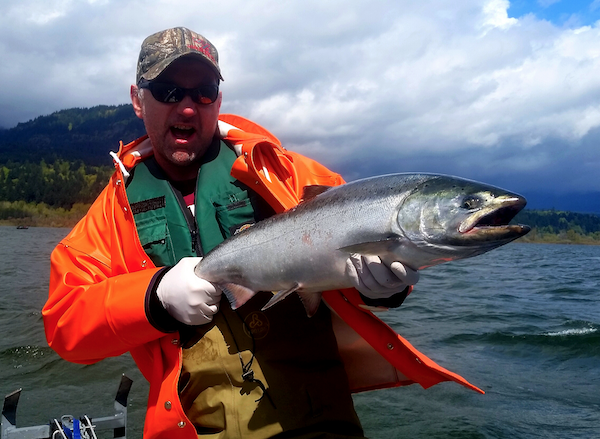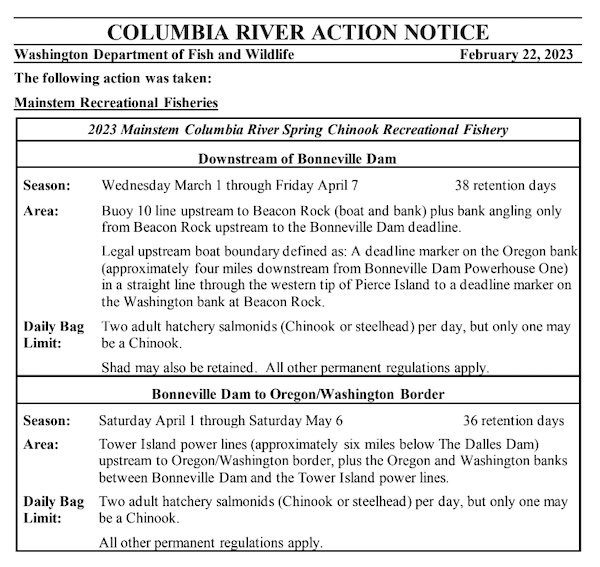States Set Columbia Spring Chinook Seasons
Editor’s note: Updated at bottom with press releases from ODFW and WDFW.
State salmon managers set spring Chinook seasons featuring a somewhat more robust catch for the Lower Columbia and its gorge pools than last year.

The decisions were in line with what staffers from the Oregon and Washington Departments of Fish and Wildlife had recommended yesterday and include:
- A 38-day, March 1-April 7 season on the big river below Bonneville with an expected kept catch of 7,766 adult hatchery springers, including 6,411 of the constraining upriver-bound kings. The waters from Beacon Rock to the dam are only open for bank fishing.
- And a 36-day, April 1-May 6 fishery from just below The Dalles Dam to the Washington-Oregon border above McNary Dam, where 845 adults are forecast to be bonked.
Daily limit is two adult hatchery salmonids, but only one Chinook.
For the Columbia below the dam, it amounts to almost 2,600 more kings than 2022’s initial season, which ran through April 6, while above there it’s 368 more.
ODFW’s Tucker Jones and WDFW’s Ryan Lothrop made the pretty straight ahead calls during a hybrid Columbia River Compact meeting that lasted two hours and 40 minutes. The proposals were also supported by sport anglers and industry representatives.

Making the long drive to participate in person were members of Idaho’s Shoshone-Bannock Tribe, including Lee Juan Tyler, who called on the state managers representing their respective agency directors to spread the sport fishery out more so impacts weren’t focused on the early segment of the Chinook return.
Bruce Jim Sr. of the Umatilla Tribe expressed concern that managers be more sure of how many salmon are coming and suggested the states allow three days of fishing and three days of letting fish go by.

Jones said he appreciated the Shoshone-Bannock and Umatilla comments – as did the sportfishing representatives – as he defended the state management.
“I’m not sure everyone appreciates just how carefully these fisheries are managed,” he said.
Along with the 30 percent runsize buffer, which effectively initially manages this year’s forecast of 198,600 fish as if just over 139,000 are coming back, there’s a 1.6 percent mortality limit on ESA-listed wild Snake River spring/summer Chinook, and given nonconcurrent allocations between Oregon and Washington, there’s essentially another 1,500 available mortalities on the table that won’t be tapped into.
“I believe fisheries are an integral part of the conservation of this resource,” said Jones, who added that he valued them whether they were commercial, tribal or recreational, held at Buoy 10 at the mouth of the Columbia or on the Yankee Fork of Idaho’s Salmon River.
The season timing – set as the run begins to build in the Lower Columbia – also helps mitigate against potential rapid overharvests.
“We can’t set fisheries at certain times of year with too many fish in the river. The fisheries become too volatile,” Jones said.
After last year’s fishery wrapped up April 6 with a slight overage based on the initial forecast, the run actually came in larger than forecast and that allowed for a reopener that ran all but one day from May 12 through June 15, the end of the states’ spring Chinook management period.
ODFW’s Jeff Whisler and Jimmy Watts outlined how going into the last few days of 2023’s early season they would have catch stats from March and up through April’s first weekend in case any emergency actions needed to be taken before Friday, April 7.
Jones and WDFW’s Lothrop also OKed recreational fisheries in the downstream Select Area Fishery Enhancement waters.

For more on how and where to fish for springers soon to surge through the Lower Columbia, check out the March issue of Northwest Sportsman.

THE FOLLOWING IS A PRESS RELEASE FROM THE OREGON DEPARTMENT OF FISH AND WILDLIFE
CLACKAMAS, Ore. – Fishery managers from Oregon and Washington adopted recreational spring Chinook seasons for the Columbia River during a joint state hearing today.
Effective March 1 (downstream of Bonneville Dam) and April 1 (upstream of Bonneville Dam), the following regulations will take the place of permanent rules for the mainstem Columbia River between Buoy 10 and the Oregon/Washington border (see 2023 regulation booklet for permanent rules).
Catch rates and fishery performance will be monitored in season. Additional fishing days may be added after an in-season update of the expected upriver spring Chinook run size in mid-May.
Downstream of Bonneville Dam
- Season: Wednesday, March 1 through Friday, April 7
- Bag limit: Two adult hatchery salmonids (Chinook or steelhead) per day, but only one may be a Chinook.
- Open area: Buoy 10 line upstream to Beacon Rock (boat and bank) plus bank angling only from Beacon Rock upstream to the Bonneville Dam deadline. Legal upstream boat boundary defined as: a deadline marker on the Oregon bank (approximately four miles downstream from Bonneville Dam Powerhouse One) in a straight line through the western tip of Pierce Island to a deadline marker on the Washington bank at Beacon Rock. For exact boundaries visit https://myodfw.com/recreation-report/fishing-report/columbia-zone
- Shad may also be retained.
Bonneville Dam to Oregon/Washington Border (upstream of McNary Dam)
- Season dates: Saturday, April 1 through Saturday, May 6
- Bag limit: Two adult hatchery salmonids (Chinook or steelhead) per day, but only one may be a Chinook.
- Open area: Tower Island power lines (approximately six miles downstream of The Dalles Dam) upstream to Oregon/Washington border, plus the Oregon and Washington banks between Bonneville Dam and the Tower Island power lines.
Prior to an in-season run size update, the fishery downstream of Bonneville Dam will be managed for a guideline of 6,487 upriver spring Chinook and the fishery between Bonneville Dam and the Oregon/Washington-state line will be managed for a guideline of 927 upriver spring Chinook (these guidelines include kept catch plus release mortalities).
Forecasts for several 2023 spring Chinook stocks have improved since last year and remain higher than the 10-year averages. The overall forecasted return of adult spring Chinook to the Columbia River mouth (including both upriver and lower river stocks) is 315,600 fish. This is an improvement over last year’s actual return of 286,954 fish and is 126 percent of the recent 10-year average.
But while the total upriver spring Chinook forecast of 198,600 adults would be higher than last year’s return and above the 10-year average of 150,485 fish, fisheries this year are constrained due to the low forecasted return of ESA-listed Snake River natural origin spring/summer Chinook.
Columbia River spring Chinook salmon seasons are driven by Endangered Species Act limitations and management agreements between the states and Columbia River Treaty Tribes specifying the total harvest guideline of upriver-origin spring Chinook.
“We carefully craft our fisheries to stay within ESA constraints and closely track actual performance throughout the season,” said Tucker Jones, Columbia River Program Manager. “We appreciated hearing from Tribes, recreational, and commercial fishermen today and thank all partners for their continued support of fish conservation.”
A run-size update is expected in May (passage at Bonneville Dam is usually 50 percent complete by May 10) and additional spring Chinook fishing opportunity may be added on the mainstem Columbia River if run size and impacts allow.
Anglers are reminded that the use of barbless hooks is required when angling for salmon or steelhead in mainstem Columbia River waters from the mouth upstream to the OR/WA state line.
As fishing regulations can change in-season, anglers are responsible for checking their angling zone in ODFW’s Recreation Report / Fishing Report before fishing, https://myodfw.com/recreation-report/fishing-report/
Fishery managers also took action today to align daily bag limit regulations between fisheries in the mainstem and Select Area sites in the estuary.
Effective March 1 through June 15, on days when the mainstem Columbia River recreational fishery below Bonneville Dam is open to retention of Chinook, the daily salmonid bag limit in Oregon and Washington Select Areas will be the same as mainstem Columbia River bag limits. On days when the mainstem Columbia River recreational fishery below Bonneville Dam is closed to Chinook retention, the permanent salmonid bag limit regulations for Select Areas apply (see Columbia River Zone permanent regulations). These waters are open year-round to Chinook salmon (hatchery only during Jan. 1 – July 31), hatchery steelhead, and hatchery coho except for some seasonal tributary closures.
###
THE FOLLOWING IS A PRESS RELEASE FROM THE WASHINGTON DEPARTMENT OF FISH AND WILDLIFE
Fishery managers from Washington and Oregon on Wednesday approved this year’s recreational spring Chinook salmon fishing season for the Columbia River, with seasons expected to look similar to 2022.
The 2023 forecast for upriver spring Chinook is 198,600 fish, slightly more than the 185,209 that returned to the Columbia River in 2022, and significantly higher than the 10-year average of 150,485 fish.
“We’re optimistic about many returns to the Columbia River this spring, and there should be some good fishing opportunities for anglers on the lower river,” said Ryan Lothrop, Columbia River fisheries manager with the Washington Department of Fish and Wildlife (WDFW). “We’re still watching some stocks closely to make sure we’re achieving our conservation goals, and those may have an impact on opportunity as we track and update the runs throughout the season.”
That includes the natural-origin Chinook returning to the Snake River and the upper Columbia spring Chinook stocks, both of which are listed under the Endangered Species Act.
Salmon fishing is now open daily from the mouth of the Columbia River to the Interstate-5 bridge under permanent regulations, but spring Chinook usually don’t arrive in large numbers until late March and April. See permanent regulations in the 2022-23 Washington Sport Fishing Rules Pamphlet.
The river will open for the following dates and locations in 2023:
- March 1 through April 7: Buoy 10 line upstream to Beacon Rock (boat and bank), plus bank angling only by hand-cast from Beacon Rock upstream to the Bonneville Dam deadline.
- Daily limit 6, including no more than 2 adults, of which no more than 1 may be an adult Chinook. Release all wild steelhead and all salmon other than hatchery Chinook. Salmon minimum size 12 inches. Shad retention is also permitted, no minimum size or daily limit.
- April 1 through May 6: From the Tower Island power lines (approximately 6 miles below The Dalles Dam) upstream to the Oregon/Washington border, plus bank angling by hand-cast only between Bonneville Dam and the Tower Island power lines.
- Daily limit 6, including no more than 2 adults of which no more than 1 may be an adult Chinook. Release all wild steelhead and all salmon other than hatchery Chinook. Salmon minimum size 12 inches.
The projected pre-update recreational fishing harvest for both upriver and lower river spring Chinook in 2023 is 7,766 adult Chinook kept for the fishery below Bonneville and 845 fish kept above Bonneville, both increases over 2022.
Managers will monitor the fisheries, dam counts, and hatchery returns and adjust as necessary in-season, with the run-size update typically occurring mid-May.
Anglers can also expect to harvest spring Chinook in the Cowlitz, Kalama, and Lewis rivers in 2023, with regulations for those fisheries listed in the 2022-23 fishing regulations pamphlet.
Salmon and steelhead rules and limits in Deep River will be the same as the mainstem Columbia River when the mainstem is open to spring Chinook retention.
Anglers should review the Washington Sport Fishing Rules pamphlet for all permanent rules for the waters they plan to fish, as well as check for any emergency rule changes before heading out. Regulations may be modified in-season as returns materialize.
The Washington Department of Fish and Wildlife works to preserve, protect, and perpetuate fish, wildlife and ecosystems while providing sustainable fish, wildlife, and recreational and commercial opportunities.

